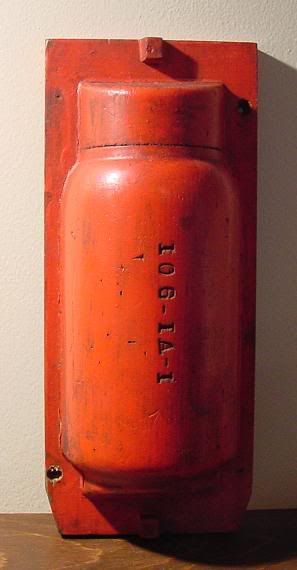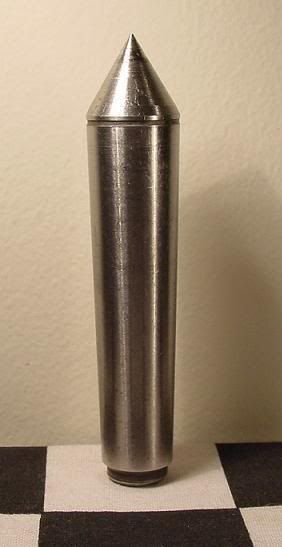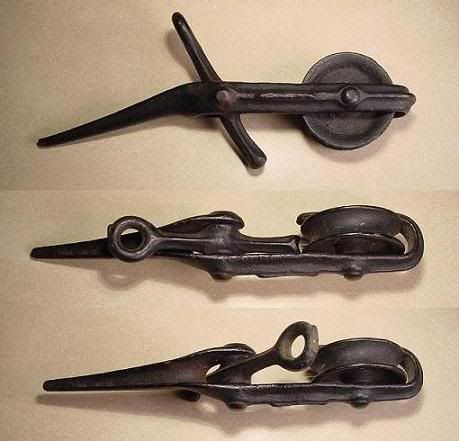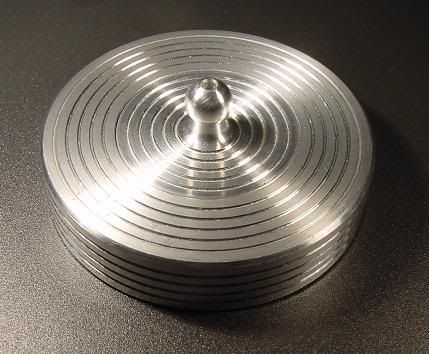130. 10" tall

131. 3 1/4" long

132. 3 1/2" tall

133. 7 1/2" long

134. 3 3/8" long. The other side of this one says "Goldblatt".

135. 2 3/4" dia.

Answers

131. 3 1/4" long

132. 3 1/2" tall

133. 7 1/2" long

134. 3 3/8" long. The other side of this one says "Goldblatt".

135. 2 3/4" dia.

Answers

11 Comments:
>I think #131 is an old razor blade dispenser
Correct, it's an old razor blade injector.
#132 looks like a live center for a lathe or milling machine.
Yes, it's for a lathe, but others have said that it's a dead center since it doesn't have bearings.
By Rob H., at 9/23/2004 3:44 PM
Rob H., at 9/23/2004 3:44 PM
Is #133 part of a sewing machine?
By Anonymous, at 9/24/2004 1:44 AM
Anonymous, at 9/24/2004 1:44 AM
>Is #133 part of a sewing machine?
No, it was used on a farm for a particular purpose.
By Rob H., at 9/24/2004 6:55 AM
Rob H., at 9/24/2004 6:55 AM
>#133: is the little lever thingy a sort of "remote release" hook or something?
It's more like a friction catch, the same rope that is tied to the eye goes through the pulley, with the lever keeping the rope from slipping. I'll explain it more when I post the answers.
>Does #134 have anything to do with bricklaying or masonry?
I'm still looking into this one, but it's probably for masonry or plastering.
By Rob H., at 9/24/2004 12:37 PM
Rob H., at 9/24/2004 12:37 PM
#134 - A device used to hold a mason's line on the ends of concrete block or brick work when running courses. Most often seen made of plastic but Goldblatt did things right.
By Anonymous, at 9/25/2004 12:17 PM
Anonymous, at 9/25/2004 12:17 PM
#133 A pulley to ride down a rope, with some kind of rope controlled brake.
By Anonymous, at 9/30/2004 4:44 PM
Anonymous, at 9/30/2004 4:44 PM
#132 A plumb bob.
By Anonymous, at 9/30/2004 4:45 PM
Anonymous, at 9/30/2004 4:45 PM
I don't think that I get very many people browsing my old post comments, so I went ahead an posted your question on the newsgroup rec.woodworking. One person was taught the same as you, others disagreed, here are some of their replies:
"The Lathe Book" by Ernie Conover says "There are two types of tailstock
centers: dead centers and live centers".
He then goes on to to describe and explain the differences and
advantages/disadvantages of each.
The "drive center" goes in the headstock and is different from dead
centers and live centers.
-Doug
Driver center - Used in Headstock - Spur or fixed screw or plate or chuck.
Used to drive work piece.
Dead center - Used in Tailstock - a fixed point, or combination of fixed
point and circle - driven into work piece - used to support the non-driven
side of work. Typically lubricated (since it does not turn with work piece)
Live Center - Used in Tailstock - a point supported by a bearing, thus
allowing the point to turn in conjunction with work piece - may be a point,
cone (inside or outside) or other device to secure with non-driven side of
the work piece.
Dave
A live center, like other living things, moves (in this case, spins).
A dead center, like other dead things, doesn't move.
John
I was also taught the "live" center is on the headstock and the "dead" center is on the tailstock. Doesn't mean it was right, but that is what I was taught.
Six or seven more responses to this question can be seen at rec.woodworking
By Rob H., at 10/18/2004 5:35 PM
Rob H., at 10/18/2004 5:35 PM
135:
It's a trick container.
There's only one way to open it without obviously damaging it.
By Anonymous, at 10/25/2004 9:41 PM
Anonymous, at 10/25/2004 9:41 PM
#132 is a metal/engine lathe center. If used in the headstock it is a live center. If used in the tailstock it is a dead center. A center that has internal bearings that allows it to spin is used in the tailstock and is called a "rotating" or "revolving" dead center.
Al Everest, Millwright, Red Deer Alberta, Canada
By Anonymous, at 2/04/2006 10:18 AM
Anonymous, at 2/04/2006 10:18 AM
#132- Is indeed a dead center. Many think that just because a center moves it is "live". In reality, the term "live" means driven.
If the work is held in a chuck, the center in the tailstock, a non driven or dead center is the only center used.
If the work is turned between centers then a "live" or driven center is used to revolve the work and a non-driven or "dead" center is used in the tailstock to center and hold the work at the oposite end.
Whether the center has bearings and rotates has no bearing(bad pun intended) as to the applied name of the center.
In a nutshell:
If the center is driven at the spindle end of the lathe and rotates the work, it is a live center.
If the center is used to center the work at the tailstock, it is a dead center.
If the center at the tailstock end is designed to turn with the work, then it is a "rotating dead center".
By Anonymous, at 10/05/2006 6:59 PM
Anonymous, at 10/05/2006 6:59 PM
Post a Comment
<< Home